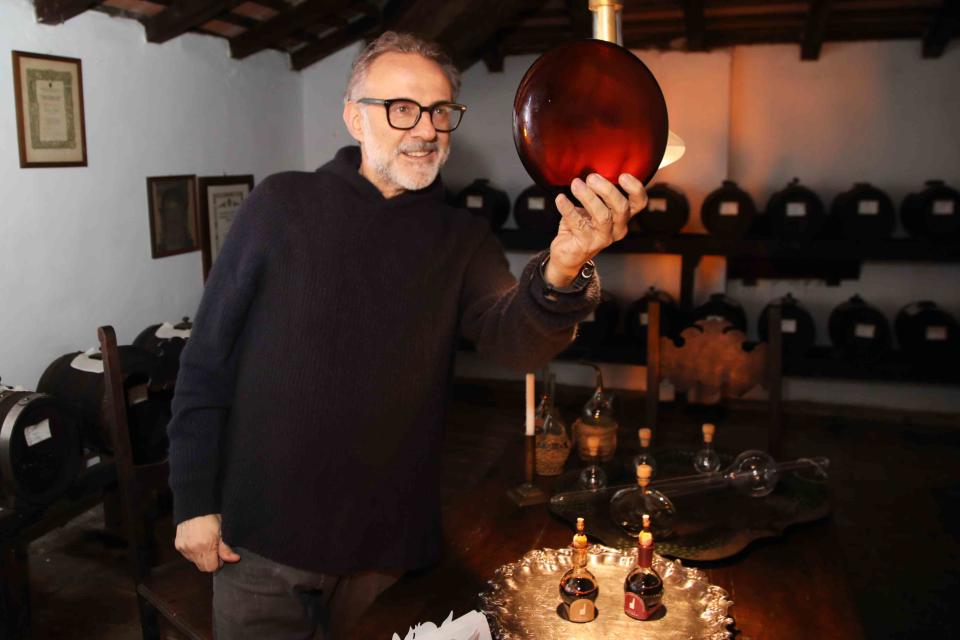How Massimo Bottura Gets the Most Out of a Bottle of Balsamic
The acclaimed chef uses balsamic in everything from cocktails to dessert.

Barnaby Draper
Turning treasured childhood memories into a business is so very Massimo Bottura. As a child in Modena, the Michelin-starred chef and his friends would collect fresh snow and top it with saba, a sweet and tangy grape syrup made much like the process for balsamic vinegar, but without the long aging process. According to Bottura, for Emilians, protecting the region’s beloved culinary products — including Parmigiano Reggiano, prosciutto di Parma, and balsamico — is a responsibility and a necessity shared by all. So when Bottura saw Villa Manodori, a beloved acetaia (a traditional site for the production of balsamic vinegar), fall into disrepair, he was determined to save it. “It was a necessity to keep tradition alive and restore the old acetaia,” Bottura told me during a recent interview at Casa Maria Luigia. “In balsamico, the business perspective is to make it overnight and sell it the next day, [but what we do], aging it for 25 years — forget about business perspective, it’s about tradition.”
Bottura spent his childhood in Modena, a city in Italy’s northern region of Emilia-Romagna, and the city he’s helped put on the map as a major culinary destination thanks to his many restaurants including the lauded Osteria Francescana and his stunning bed and breakfast, Casa Maria Luigia. With a team of experts, Bottura spent 12 years transporting hundreds of delicate wooden barrels filled with aging balsamic from the old acetaia to his property at Casa Maria Luiga. The team carefully repaired each barrel, some almost 100 years old, so as not to lose any of the balsamico. “Only when everything is repaired can we begin to play with the flavors,” Bottura said during a recent tour of the acetaia, an experience I had with American Express’ By Invitation Only program.
Related: What It’s Like to Have Dinner at Osteria Francescana
Bottura uses juniper and cherry wood casks to make balsamic with distinctly different flavor profiles; the juniper is grassy and verdant, the cherry sweet and fruity. Since the youngest mother casks (to which new vinegar is blended) are from the 1980s, every bottle of balsamic from Villa Manodori is at least 40 years old, and boasts a thick, syrupy texture and profound flavor. With such a superb product just steps away from his newest restaurant Al Gatto Verde, it’s no surprise that Bottura has delicious, unexpected uses for Modena’s beloved balsamico — here are five to try out now.
Use balsamic in a marinade
At Al Gatto Verde, Bottura teamed up with Canadian chef Jessica Rosval to craft a menu highlighting cooking with smoke and fire. A standout dish called “Short Ribs Forever” is made from hefty beef short ribs that have been marinated in balsamic. The acid in the vinegar tenderizes the short ribs, and the earthy, fruity, and tart notes soak deep into the center of the meat. “The combination of balsamico and American barbecue is natural,” says Bottura, “The blend of long cooking, sweetness, and acidity is classic. We use our cherry balsamic on baby back ribs, too.” Balsamic adds depth of flavor to a marinade for any umami-rich food from mushrooms, steak, or pork chops.
Dress a fruit salad with balsamic
“I love to use the balsamico aged in cherry wood in a beautiful fruit salad with raspberries, blueberries, and strawberries,” says Bottura. He prefers the sweet notes of balsamic aged in cherry, chestnut, or mulberry wood to steer away from the more vegetal flavors sometimes imparted by aging in juniper or oak. Strawberries and balsamic are a classic combination, but adding a variety of fruits from melon to mango can play off different kinds of notes in the balsamic. “You can even top the fruit salad with a bit of vanilla ice cream and a last drizzle of balsamico,” Bottura said, smiling.
Use balsamic in a cocktail
The range of flavors present in balsamic vinegars makes it a versatile ingredient for mixing into cocktails. Bottura suggests adding a few drops of balsamic, especially one aged in savory juniper barrels, to a gin and tonic. This pairing works well because for a spirit to be labeled as gin, it must be made with juniper. Some gins are flavored solely with juniper, but others add other botanicals like lemon or whole spices like coriander or clove as well. The juniper-balsamic combination works with the aromatic notes in th gin and it also plays well with the herbaceous flavor from the tonic water. Looking for a bit of heat? Try balsamic vinegar in a piquant strawberry-chile shrub.
Related: How Massimo Bottura Turns Leftover Parmigiano Rinds Into Bouncy Noodles
Drizzle balsamic over Parmigiano
As the old school saying goes, what grows together goes together. This adage is most certainly true for the simple yet elegant combination of Parmigiano Reggiano and balsamic. Perhaps the best way to appreciate aged balsamic is to simply take a chunk of Parmigiano Reggiano and drizzle a bit of vinegar on top. It’s a classic combination that amplifies both ingredients.
Swirl balsamic into cheesecake
To take the pairing of balsamic and cheese a step further, Bottura adds a swirl of aged balsamic to the top of the cheesecake at Al Gatto Verde. The vinegar cuts through the sweet and creamy cake, adding welcome tang and zip. To achieve this effect at home, serve cheesecake with a drizzle of balsamic, or swirl it into the top of the cake before baking.
For more Food & Wine news, make sure to sign up for our newsletter!
Read the original article on Food & Wine.

